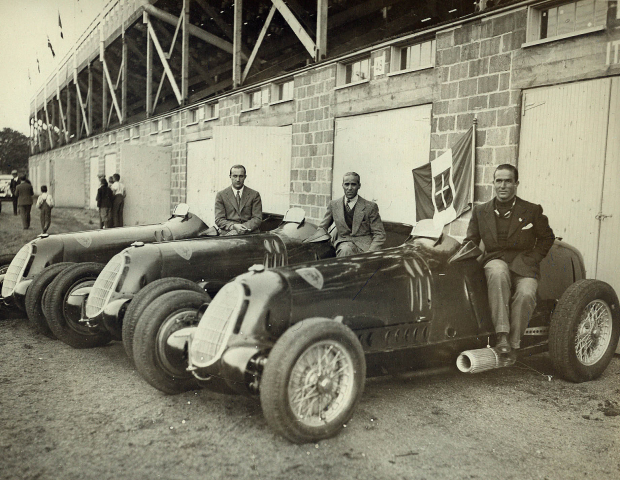From the Drennan Collection: 1937 Roosevelt Raceway “Australia” Mystery Solved

Onelung: Question: "One of the 1936 Vanderbilt Cup Race photos in the April 9, 2010 post shows the Italian Alfa Romeo team in front of garages at Roosevelt Raceway. You can clearly see the beginning of the word ITALY above one of them. Can you explain why "Australia" appears on the door in the background of a 1937 Vanderbilt Cup Race photo that I found on the web?"
This is the 1937 Vanderbilt Cup Race photo posted by Onelung on jalopyjournal.com. It shows the eventual winner #4 Auto Union Type C racer driven by Bernd Rosemeyer at the Roosevelt Raceway garages. Note: The swastika that was present on all Auto Union and Mercedes cars for the 1937 race. The symbol was typically placed on cars for races held only within German borders. The reason for the offensive swastika at the Long Island race was unclear and, indicative of the calm before the storm, not protested by the media or track promoters.
A close-up of the copy above the garage door over the #4 Auto Union definitely reads "Australia". The mystery: There were no Australian cars or drivers entered in the 1937 Vanderbilt Cup Race. The solution lies in the 1936 Program Guide and another unpublished glass negative from the Drennan Collection.
As shown by the official program guide, the 1936 Vanderbilt Cup Race was promoted as a major international race. The flags of the US, France, Great Britain, Australia and Italy were prominently displayed on the cover. Although, no Australian cars were entered in this race, the inclusion of "Australia" is likely revealed in this previously unpublished image from the Drennan Collection discovered by the Cradle of Aviation.
This is the #12 Maserati 6CM driven by Frederick McElroy which finished 6th at the 1936 Vanderbilt Cup Race. Although its manufacturer was Italian and raced throughout Europe, the car had the Australian flag on its side simply because McElroy was born in Australia!
Accordingly, I believe the slightly faded copy "Australia" in the 1937 photo was neglected signage for the garage that was used by the "Australian" Frederick McElroy's Italian Maserati during the 1936 race.
November 12, 2011 Update: On November 19, 1951, Time Magazine published this dramatic account of the death of Freddy McEvoy "Morocco: Death of a Playboy".
At the Stork Club, in Paris, on the Riviera and in London’s West End, everybody who was anybody knew Freddy McEvoy. Born to obscurity, the tall, handsome, 44-year-old Australian had the gift of making friends, news, money, and marrying heiresses. His feats of derring-do on the high seas, in the game-filled jungles of Africa and on the icy ski runs of Switzerland gave the international set a vicarious sense of adventure, and earned him the nickname Suicide Freddy. His zesty approach to business matters—he launched the fashion of flowered shirts for men by selling his own right off his back to an Argentine millionaire for $2,000—made him several fortunes. His careless gallantry in the drawing room earned him the undying affection of many, including his first wife, oil heiress Beatrice Benjamin Cartwright.
He and Cartwright had lived together at the Badrutt Palace in St. Moritz for several winters, prior to their marriage. One year, McEvoy brought home a much younger model to “care for him,” explaining to Cartwright that he needed a younger bedfellow than her. The marriage lasted two years. When they were divorced, he married Irene Wrightsman, 18-year-old daughter of the president of Standard Oil of Kansas. That marriage also lasted but two years, and he spent most of 1944 going back and forth from Mexico City to Beverly Hills, smuggling arms, jewelry, liquor and other valuables into the United States.
When rollicking Errol Flynn was hauled into court in 1943 on charges of statutory rape, Freddy McEvoy stood by to say it wasn’t so; Errol was acquitted. When in 1949 Freddy married his third wife, 26 year old French model Claude Stephanie, Errol stood up as best man.
Last week, heeding the call of the westering sun and the social season at Nassau, Freddy and Claude boarded their schooner, Kangaroo, and set sail for the Bahamas. A strong southwest gale was rising as the vessel rounded Cape Cantin off the Moroccan coast. The wind seized the yacht, drove it inshore and dashed it on the reefs. A surging wave flung a steward overboard to his death. Another knocked Claude’s French maid Cecile to the deck. McEvoy’s crewmen picked her up and lashed her to a mast for safety, but a moment later the wind tore her loose, and she was washed away.
All night long winds and sea pounded the yacht while Claude clung desperately to a spar. Before dawn the ship’s cook went mad and drowned himself. At daybreak three sailors succeeded in swimming ashore. The last aboard the yacht, Freddy and Claude, both good swimmers, finally decided to chance it. Side by side they dived into the water. Freddy was within two yards of the beach when he looked back and saw his beautiful wife was in trouble; the playboy-millionaire turned seaward once again. The effort was too much. Just as he reached his wife, Freddy’s strength gave out. A great wave engulfed and drowned them both.
Related posts on VanderbiltCupRaces.com:
Archives: 1936 Vanderbilt Cup Race, Roosevelt Raceway, Westbury, New York
Archives: Images from the Drennan Collection







Comments
Hi Howard,
many thanks for your information re McElroy and the “Australia” sign from 1936.
It seems he was “a bit of a character”, to put it mildly, and perhaps in the same swash-buckling mould as another Aussie, Errol Flyn!
Congratulations on your Vanderbilt Cup site: it is truly exemplary.
Regards, Geoff “onelung” Chennells
Adelaide, South Australia.
__________________